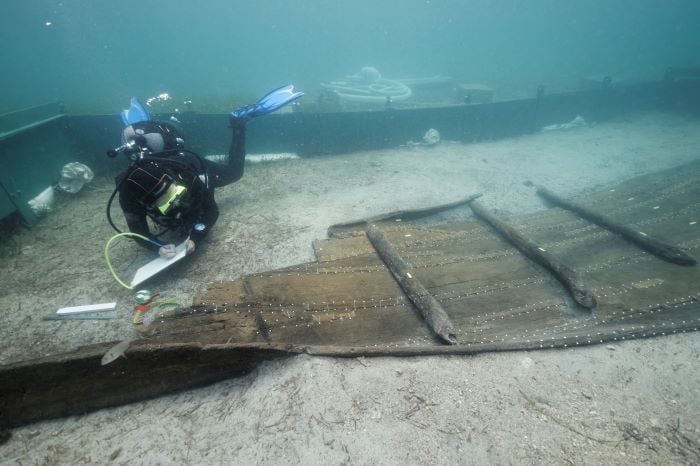
The Zambratija, the oldest boat in the Mediterranean built entirely by hand, is about to begin a new phase in its long history. This ancient shipwreck, lying on the Adriatic seafloor in Croatia for thousands of years, is now getting ready for a special trip to France.
There, experts will work to preserve and study it. This historic boat was found in the Bay of Zambratija close to Umag on Croatia’s Istrian peninsula.
Ancient boat dates back between late 12th to late 10th century BCE
A team of archaeologists headed by underwater archaeologist Ida Koncani Uhac from the Archaeological Museum of Istria has confirmed the boat originates from the late twelfth to late tenth century BCE. This time frame signifies a shift from the Bronze Age to the Iron Age.
Ida Koncani Uhac highlighted the importance of this discovery, saying it serves as the model for all sixty-four handmade boats found in the Mediterranean.
The story of the Zambratija boat began in 2008, when a nearby fisherman informed archaeologists about the wooden vessel’s remnants.
Divers are about to pull a 3,000-year-old shipwreck from sea.
The sewn boat of Zambratija, which sank off the coast of Croatia, has endured the test of time remarkably well.
(1/3) pic.twitter.com/w7rVJ4q34v
— HistoryThreeThousand (@History_3000) December 28, 2023
Although it was merely 150 meters from the shore and only partially visible with one frame and five planks, the boat’s unique underwater conditions, shielded by sea mud, kept it from degrading due to oxygen and harmful bacteria.
Originally assumed to be a boat from the Roman era, scientists were taken aback when further examination using radiocarbon dating revealed a much older origin.
The boat, stitched together with ropes made of plant fibers specifically from the Spanish broom (Spartium junceum), is believed to have served as a mastless vessel for seven to nine rowers.
Ida Koncani Uhac said this kind of boat might have been utilized by the Histri, a local tribe after whom Istria was named.
These hand sewn boats might be used by Histri
In the following years, the Histri possibly used comparable boats for piracy in the northern Adriatic, intercepting Roman ships transporting grain for their troops.
The careful retrieval of the Zambratija took place in July, requiring the boat to be lifted in fifteen distinct pieces.
These were later moved to a museum hangar, where they underwent cleaning, analysis, and tagging. Afterward, the fifteen pieces were put in a specially designed pool for desalination.
Monika Petrovic, the restorer involved in the project, noted the meticulous care taken during the conservation process and jokingly referred to the historic find as “our wooden planks.”
The next step involves transporting these shipwreck fragments from the Mediterranean Sea to the Arc-Nucleart research laboratory in Grenoble, France for the continuation of the conservation process.
See all the latest news from Greece and the world at Greekreporter.com. Contact our newsroom to report an update or send your story, photos and videos. Follow GR on Google News and subscribe here to our daily email!



